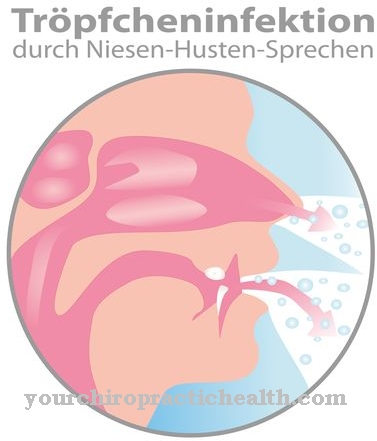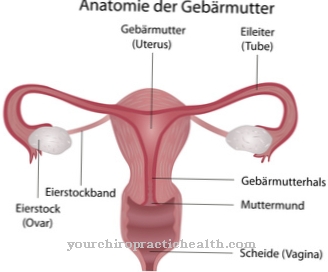Of the Klatskin tumor is one of the biliary tract carcinomas. It is considered a special form of cholangiocellular carcinoma.
What is a Klatskin tumor?

© marina_ua - stock.adobe.com
At the Klatskin tumor it is a malignant tumor that forms on the central biliary tract. It represents a special variant of biliary carcinoma. The Klatskin tumor is positioned on the hepatic fork. At this point the right and left liver ducts unite to form a common duct. In medicine, the tumor is also called carcinoma of the hepatic fork or bifurcation carcinoma. People between the ages of 60 and 70 are particularly affected by Klatskin tumors.
causes
The Klatskin tumor is counted among the cholangiocellular carcinomas, the causes of which are still unclear. For this reason, no exact trigger for the development of the rare disease has yet been found. However, certain risk factors are known that can promote the occurrence of a Klatskin tumor. These include previous illnesses such as gallstones in the liver (hepatolithiasis), primary sclerosing cholangitis, Caroli syndrome and a common bile duct cyst.
Another risk factor is infections with parasites such as Clonorchis sinensis and Opisthorchis viverrini. These diseases occur primarily in China and Thailand. Doctors divide the Klatskin tumor into two forms. These are the polypoid intraluminal type and the diffuse infiltrating type. With both forms there is the possibility that they merge into one another. They attack the liver along the biliary tract.
In about half of all malignancies, metastases to the lymph nodes can also be identified during diagnosis. The Klatskin tumor infiltrates the perineural sheaths at an early stage, which can go as far as the periortic nerve plexus. Since the spread of the tumor is difficult to determine with imaging examination methods, only a histological examination shows its extent.
The Klatskin tumor is also divided into types I to IV. In type I, the fork of the hepatic nerve is not affected by the carcinoma that forms in the bile ducts. If, on the other hand, the fork of the hepatic nerve is involved, it is called type II. In the case of type III, the tumor reaches the segmental branches on one side. If type IV is present, the secondary confluences on the right and left are affected. A curative resection can no longer be performed.
Symptoms, ailments & signs
The development of a Klatskin tumor is in most cases not even noticed by the patient. Symptoms only arise when the tumor increases in size. Then the gallbladder enlarges below the right rib, which is painless. In addition, those affected suffer from severe jaundice (jaundice). Mostly there is also a greater loss of weight.
Other symptoms can include itching and fatty stools (steatorrhea). In addition, the Klatskin tumor penetrates into the liver. In the further course there are symptoms in the upper abdomen, loss of appetite and fatigue. Jaundice, which sets in early, is caused by a blockage of the biliary tract. This disrupts the outflow of the bile pigment bilirubin.
The absence of bile acid in the intestine means that fatty acids and trialcylglycerides do not enter into conjugation. In addition, they can no longer be split and taken up by the lipases. Because they stay within the intestinal lumen, the stool becomes fatty.
Diagnosis & disease progression
Several diagnostic methods are suitable for diagnosing a Klatskin tumor. This is usually a blood test for changes in the bile and liver values. In addition, an abdominal sonography (ultrasound examination of the abdomen) takes place. As part of an X-ray examination, the patient first takes a contrast agent to make the biliary tract visible.
In this way, narrowing of the biliary tract caused by a tumor can be identified. Magnetic resonance cholangiopancreatography (MRCP) can also be performed to visualize tumor stenosis. There is no risk of germs being carried over by a contrast agent. However, the entire extent of the Klatskin tumor cannot be visualized by the imaging process because it spreads to the nerve sheaths. However, its core area is usually well recognized.
A Klatskin tumor often takes a negative course. It has usually grown so much at the time of diagnosis that an operation can no longer be performed. For this reason, life expectancy with this disease is considered to be low. Only about five percent of all patients are still alive five years after diagnosis.
Complications
Since the Klatskin tumor is a cancer, it comes with the usual complications and risks of tumor disease. In an unfavorable case or if treatment is initiated late, this tumor can spread to other regions of the body and thus affect other healthy tissue. As a rule, this can also lead to a reduced life expectancy.
In the worst case, the affected person dies as a result of the tumor. It is not uncommon for the Klatskin tumor to lead to jaundice and severe weight loss. In many cases, people also experience abdominal pain and loss of appetite. Deficiency symptoms and a fatty stool continue to occur. The quality of life of the person affected is considerably restricted by the Klatskin tumor and the resilience also drops sharply.
The tumor is relatively easy to diagnose, so treatment can be started early. However, the tumor cannot be treated and removed successfully in every case. The removal is carried out by a surgical procedure and then by radiation. Most of the time, the person affected is dependent on check-ups even after treatment. Life expectancy may be reduced as a result of the Klatskin tumor.
When should you go to the doctor?
If symptoms of jaundice are noticed, a doctor should be sought immediately. The Klatskin tumor usually slowly increases in size. Early treatment prevents permanent damage to the gallbladder and surrounding organs. If other symptoms occur, such as noticeable weight loss or problems with bowel movements (e.g. fatty stool), medical advice is required. People who seem tired and exhausted for no reason should also speak to a doctor.
The Klatskin tumor occurs in connection with gallstones, Caroli's syndrome and primarily sclerosing cholangitis. Patients suffering from one of these diseases should consult their doctor. Even after parasitic infections such as Clonorchis sinensi and Opisthorchis viverrini there is an increased risk of developing a Klatskin tumor - an immediate diagnosis is indicated. At the latest when pain occurs in other parts of the body, you must go to your doctor with the symptoms. Other contact persons are the internist or a specialist in gallbladder diseases.
Therapy & Treatment
As part of a treatment for Klatskin's tumor, an attempt is made to decompress the blocked biliary tract. The best method for this is endoscopic retrograde cholangiopancreatography (ERC), in which the patient is given a stent. A transpapillary drainage is preferred to a transcutaneous transhepatic drainage. It is necessary to drain the bile to the outside, as it is important for digestion in the intestine.
It may be necessary to create an initial transhepatic approach in advance. This is then converted into an internal stent, the drainage of which extends into the duodenum. If the Klatskin tumor can still be surgically removed, it will be carried out. This is followed by chemotherapy. If surgery can no longer be performed, radiation therapy or chemotherapy is given.
Since the diagnosis is usually made late, in most cases it is no longer possible to achieve freedom from tumors. Therefore, symptomatic treatment is usually used, the aim of which is to combat jaundice, indigestion, and itching.
Outlook & forecast
Unfortunately, the prognosis and outlook for Klatskin's tumor is very poor.Due to the usually very late diagnosis, only very advanced stages of the disease are recognized and can therefore only be treated inadequately. Because the tumor is then usually very scattered and therefore inoperable, overall life expectancy is very poor, and only a few patients survive longer than five years after the initial diagnosis. If an operation is still possible, it is very radical in order to remove the tumor as completely as possible. Great progress has already been made here in recent years.
If this curative and life-prolonging option can no longer be carried out, palliative measures are taken to guarantee the patient a higher quality of life, the freedom from pain and the activity of those affected are the focus here. One measure, for example, is splinting the bile ducts in order to prevent bile congestion and thus liver damage. The patient can also be offered a combination of palliative chemotherapy or radiation treatment of the tumor; in the palliative concept, the focus is on the patient and can determine which therapies he or she would like to take advantage of.
prevention
Because the exact causes of a Klatskin tumor are unknown, no effective preventive measures are available.
Aftercare
Follow-up care immediately follows the initial treatment of a tumor. Doctors want to prevent recurrence of symptoms and improve life expectancy by starting treatment early. The Klatskin tumor also belongs to the group of these diseases. For the type of aftercare, it is crucial whether an operation is possible or not.
If a surgical intervention can no longer be carried out, only palliative follow-up care takes place. That means: A permanent treatment begins until the end of life, in which symptoms are alleviated as best as possible. If, on the other hand, an operation promises success, this leads to close follow-up checks. Depending on the progress of the tumor formation, follow-up care may initially be necessary after six weeks.
With increasing freedom from symptoms, the rhythm expands. After the fifth year without a new disease, doctors generally recommend follow-up care once a year. Follow-up care usually takes place in the hospital of the first surgery. The diagnosis is based on a blood sample. Imaging methods, namely computed tomography, magnetic resonance tomography and endoscopic examinations, are also mostly used.
A rehabilitation measure can follow the first intervention. In this, the integration of the patient into everyday life is targeted. Psychological and social problems can be addressed. Pain medication can also be set there.
You can do that yourself
If a Klatskin tumor has been diagnosed, it is important to surgically remove it as soon as possible. An early operation is necessary to prevent a further enlargement of the carcinoma and thus a negative outcome. Only the doctor in charge can answer which measures the patient can take.
In general, the usual preoperative measures should be taken to ensure a complication-free process. After the procedure, rest and bed rest apply to those affected. The diet may need to be changed because the gallbladder has been weakened by the surgery. In addition, regular check-ups with a doctor are indicated. There is always the risk that recurrences will occur or that the procedure will cause gallbladder disorders even after months or years. That is why close medical supervision is the most important self-help measure.
If the Klatskin tumor is discovered too late, therapeutic advice is advisable. The relatively short life expectancy can cause shock, which is why psychological support, but also the help of friends and family members, is necessary. Symptomatic treatment is still possible and can be supported by those affected by general measures such as a healthy lifestyle and restraint.



























